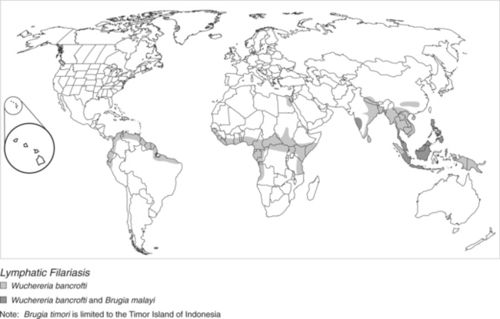提供: Vaccipedia | Resources for Vaccines, Tropical medicine and Travel medicine
ナビゲーションに移動
検索に移動
| Navigation Menu
|

|
| General issues of Vaccine
|
|
|
| General issues of Tropical med.
|
|
|
| General issues of Travel med.
|
|
|
| Trematode (fluke, distoma)
|
|
|

- ヒト体内でadultから生まれたmicrofilariaは吸血で蚊に移行し,蚊の体内で3回moltを繰り返してL3 larvaeに至る.
- L3は1.7mmまで体長を増し,吸血によって蚊の体外に放出され,蚊が生じた穿刺口等から皮内に侵入する
- 1.7mmもの体長のlarvaeがどうやって体長10mmに満たない蚊の体内で共存できるのか?
- Onchocerciasisのヒト体内の病態生理はmicrofilariaによるが,lymphatic filariasisはadultによる.
- Lymphatic filariasisでリンパ浮腫を生じている患者の下肢をエコーで観察すると,拡張したリンパ管内で蠢くadult filariaを観察できる.
Filarial dance under ultrasonography
distribution

Brugia malayi
| Intermediate host
|
| Category
|
mosquito, female
|
| Latin
|
Mansonia spp., Aedes spp.
|
| Inward infection
|
blood-feeding of human
|
| Organ
|
midgut, thoracic muscle, proboscis
|
| Reproduction
|
|
| Course
|
- microfilariae lose sheath
- migrate to thoracic muscle
- metamorphoses L1→L2→L3 in thoracic muscle
- L3 migrate to proboscis
|
| Detection
|
|
| Outward transmission
|
blood-feeding of human through proboscis
|
| Definitive host
|
| Category
|
HUMAN
|
| Latin
|
|
| Inward infection
|
blood-feeding by mosquito
|
| Organ
|
lymphatics, blood stream
|
| Reproduction
|
sexual
|
| Course
|
- L3 invade through cleavage on skin
- L3 migrate to lymphatics
- develop to adult
- female 43-55 mm, male 13-23 mm
- obstruct lymphatics resulted in elephantiasis and hydrocele in years
- mate in lymphatics
- produce sheathed microfilariae (no egg)
- 177-230 µm
- nocturnal periodicity
- microfilariae migrate to blood circulation
|
| Detection
|
- microscopy, microfilariae, Giemsa stain, blood taken nocturnally
- concentration technique
- 2% formalin to blood (Knott's technique)
- polycarbonate membrane filtration
|
| Outward transmission
|
blood-feeding by mosquito
|
Wuchereria bancrofti
| Intermediate host
|
| Category
|
mosquito, female
|
| Latin
|
Aedes spp., Anopheles spp., Culex spp., Mansonia spp., Coquillettida juxtamansonia
|
| Inward infection
|
blood-feeding of human
|
| Organ
|
midgut, thoracic muscle, proboscis
|
| Reproduction
|
|
| Course
|
- microfilariae lose sheath
- migrate to thoracic muscle
- metamorphoses L1→L2→L3 in thoracic muscle
- L3 migrate to proboscis
|
| Detection
|
|
| Outward transmission
|
blood-feeding of human through proboscis
|
| Definitive host
|
| Category
|
HUMAN
|
| Latin
|
|
| Inward infection
|
blood-feeding by mosquito
|
| Organ
|
lymphatics, blood stream
|
| Reproduction
|
sexual
|
| Course
|
- L3 invade through cleavage on skin
- L3 migrate to lymphatics
- develop to adult
- female 80-100 mm, male 40 mm
- obstruct lymphatics resulted in elephantiasis and hydrocele in years
- mate in lymphatics
- produce sheathed microfilariae (no egg)
- 244-296 µm
- nocturnal periodicity
- microfilariae migrate to blood circulation
|
| Detection
|
- microscopy, microfilariae, Giemsa stain, blood taken nocturnally
- concentration technique
- 2% formalin to blood (Knott's technique)
- polycarbonate membrane filtration
- blood Ag RDT; rapid immunochromatographic antigen test (ICT card test)
- urine Ab ELISA; high sensitivity and specificity
|
| Outward transmission
|
blood-feeding by mosquito
|
mass drug administration MDA
- Diethylcarbamazepine (DEC) 6mg/kg only once for all inhabitant in endemic area
- repeated several consecutive years
